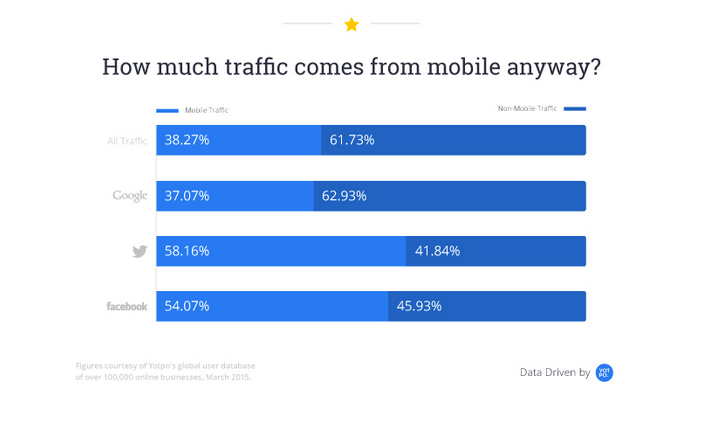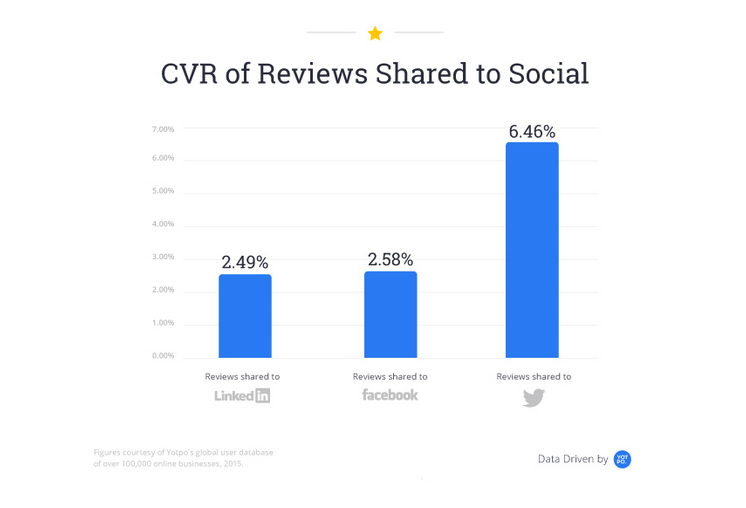Guest post by Aimee Millwood
It hasn’t been long since Google’s mobile update hit, and many eCommerce stores are assessing the damages and looking towards the future to see how they can be as best optimized for mobile as possible.
When creating a strategy for optimizing your eCommerce marketing for mobile, there are a few main things to pay attention to:
- Social marketing
- Mobile SEO
- Mobile-specific campaigns
- Catering to multiple devices
So, before we get started, let’s take a look at why mobile matters. Data collected from over 100,000 eCommerce stores shows that mobile accounts for about half of all traffic on average. For social media, these numbers are even higher.
When it comes to optimizing your eCommerce mobile marketing, it’s about more than just creating mobile-friendly campaigns and content.

As you can see from the above data, Facebook and Twitter get a whole lot more mobile traffic than Google. Given that social media gets the highest percentage of mobile traffic, it’s important to prepare your social profiles for mobile.
How to prepare your social marketing for mobile
The first step to optimizing your eCommerce social marketing for mobile users is understanding why so many social browsers are on mobile in the first place.
Mobile is often used as just one device in the ever-complicated path to purchase – and most often, customers use mobile during the initial phases when they are just learning about brands.
So, don’t worry too much about pushing conversions on them – use social proof, user-generated content, and other social signals to earn browsers’ trust. You see, people often scroll through social profiles while on the go, killing time, or in between other tasks.
For this reason, in order to optimize social for mobile traffic, you need to create bite-sized content that aims to build awareness rather than driving home a final purchase.
They’re likely not going to drop everything they’re doing when they see an ad for your store and run to purchase whatever you’re selling.
More likely, they’ll see that some friends liked your brand on Facebook, or shared a photo to your Instagram, or re-Tweeted your Tweet. A few weeks later, they’ll come back to see your brand somewhere else on social media and recognize it, although they may still not have any idea what you do or what you’re selling.
Later, they may happen across another friend who wrote a review for your product, or commented on one of your photos, and it’s only now that your brand will have become present enough in their social sphere that they will check to see what you’re all about.
When it comes to preparing for social and mobile, think of coming at it purely from a content marketing perspective: you want to build up trust and awareness so that you’re on their radar, not necessarily push them to purchase.
Using Social Marketing to Grow Social Mobile Traffic
Growing traffic from social is a slow (but powerful) process. And it’s suited to no place better than mobile.
Often distracted, on the go, and hounded by countless other content, mobile users are similar to social browsers in that they need something to really stand out to catch their eye.
They’re like window shoppers – so think of social channels as your window display, and your eCommerce front as the place where you’re actually going to get the conversions.
On social, focus on short and sweet content and boosting your content’s impact with social proof. Social referrals and shared reviews can significantly impact the results you see from social.
Take a look at how reviews increase conversion from social channels:
According to a recent study on social by Shopify, the average conversion rate for Facebook is 1.85%, the average conversion rate for Twitter is 0.77%, and the average rate for LinkedIn is .47%. Now, check out the conversion rate of reviews shared to social.
On desktop and mobile, reviews and other forms of social referrals have enormous influence on visitors. However, on mobile, this social proof also boosts the power of the awareness stage, before customers are ready to purchase.
Seeing that friends and others in their social networks approve of your brand and products creates snap judgements that will go on to impact them throughout their journey to purchase.
How to prepare your SEO for mobile
Social marketing is important, but it’s also necessary to make sure your mobile SEO is optimized. Part of marketing is driving organic content, and when it comes to mobile, it’s important to make sure your mobile SEO is doing well.
First, check to see if your store is mobile friendly (according to Google) using this nifty tool. If you don’t pass the test, check to see how you can make your site more mobile friendly.
Also, don’t forget about other search engines. Google isn’t everything. In fact, our data shows that for eCommerce stores, Bing plays a significant role in driving quality traffic. Not only is Bing one of the top five eCommerce traffic sources, but it also navigates deeper into the site than any other major traffic channel.
Across search engines, the requirements for being mobile friendly don’t differ too drastically. For both, websites need to be easy to navigate by touch, readable with zooming and while scrolling horizontally and taking measures to be compatible with mobile devices (like not using Flash). The difference though is that Google is penalizing sites that aren’t mobile friendly, while Bing currently isn’t.
Use mobile-specific campaigns
Marketers are quickly realizing mobile marketing campaigns are a whole different ballpark. Trying to simply overlay traditional methods on new technologies has been disastrous.
Everyone’s talking about how eCommerce marketers need to think mobile, but few are explaining what this really means.
For one, marketers need to re-think how you present content and what this content communicates. Content needs to be formatted to easily read on mobile and also adjusted to the on-the-go nature of mobile users.
Additionally, mobile marketers should take advantage of the unique technology mobile has: integrating location-based and interactive campaigns that don’t look at mobile as an obstacle to be dealt with, but a new opportunity for creative marketing. These eCommerce marketing campaigns show that with inspiration and innovation, mobile can be used for a new kind of marketing.
Most of all, you should remember that not all mobile is created equally. Mobile marketing campaigns should be catered to the device and behaviours of specific users. An iPhone user needs a different type of marketing than someone on a tablet. Consider how each mobile experience is catered to the specific device.
Additionally, you can tap into the potential of omnichannel campaigns by creating a seamless experience across devices. When it comes to mobile marketing, remember that your campaigns should be both device specific and device encompassing. They should translate well across devices, while still containing strategies specific to each device.
About the author, Aimee Millwood
Aimee is a former travel blogger whose curiosity about the world around her fuels her obsession with staying ahead of international marketing and business trends. She used to travel around the globe, but now she travels around the office – you can find her in a new seat every day. @aimeemillwood

